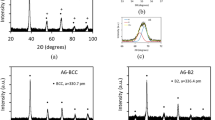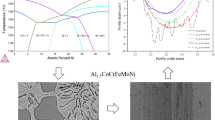Abstract
The electronic mechanism behind the brittle fracture of trialuminide alloys is investigated using the full-potential linearized augmented plane-wave (FLAPW) total-energy method within the local density functional approach. To this end, the bulk phase stability, the elastic constants, the anti-phase boundary (APB) energy, the superlattice intrinsic stacking fault (SISF) energy, and the cleavage energy on different crystallographic planes have been determined. A small energy difference (=0.10 eV/unit formula) is found between the DO22 and L12 structures of Al3Ti. In general, the trialuminide alloys have large elastic modulus, small Poisson’s ratio, and small shear modulus to bulk modulus ratio. An extremely high APB energy (=670 mJ/m2) on the (111) plane is found for Al3Sc, indicating that the separation between ½(110) partials of a (110)(111) superdislocation is small. Since the total superdislocation has to be nucleated essentially at the same time, a high critical stress factor for dislocation emission at the crack tip is suggested. The high APB energy on the (111) plane is attributed to the directional bonding of Sc(d-electron)-Al(p-electron). The same type of directional bonds is also found for Al3Ti. In addition, moderately high values of SISF energy (=265 mJ/m2) on the (111) plane and APB energy (=450 mJ/m2) on the (100) plane are found for Al3Sc. The brittle fracture of trialuminide alloys is attributed to the higher stacking fault energies and a lower cleavage strength compared to those of a ductile alloy (e.g., Ni3Al). While the (110) surface has the highest surface energy, the cleavage strength (=19 GPa) of Al3Sc is found to be essentially independent of the crystallographic planes. The directional Sc—Al bond becomes even stronger on the (110) surface, which may explain the preferred (110) type cleavage observed by experiment.
Similar content being viewed by others
References
M. Yamaguchi, Y. Umakoshi, and T. Yamane, Phil. Mag. A 55, 301 (1987).
Y. Umakoshi, M. Yamaguchi, T. Yamane, and T. Hirano, Phil. Mag. A 58, 651 (1988).
E. P. George, W. D. Porter, H. M. Henson, W. C. Oliver, and B. F. Oliver, J. of Mater. Res. 4 (1), 78 (1989).
C. D. Turner, W. O. Powers, and J. A. Wert, Acta Metall. (to be published).
S. C. Huang, E. L. Hall, and M. F. X. Gigliotti, J. Mater. Res. 3 (1), 1 (1988).
J. Tarnacki and Y. W. Kim, Scripta Metall. 22, 329 (1988).
J. H. Schneibel, P. F. Becher, and J. A. Horton, J. Mater. Res. 3 (6), 1272 (1988).
A. E. Carlsson and P. J. Meschter, J. Mater. Res. 4 (5), 1060 (1989).
T. Hong, T. J. Watson-Yang, T. Oguchi, and A. J. Freeman (to be published).
D. M. Nicholson, G. M. Stocks, W. M. Temmerman, P. Sterne, and D. G. Pettifor, in High-Temperature Ordered Intermetallic Alloys III (MRS, 1989), p. 17.
James R. Rice and Robb Thomson, Phil. Mag. 29, 73 (1974).
M. L. Jokl, V. Vitek, and C. J. McMahon, Jr., Acta Metall. 28, 1479 (1980).
S. M. Ohr, Mater. Sci. and Eng. 72, 1 (1985); and the references therein.
P. Hohenberg and W. Kohn, Phys. Rev. B 136, 864 (1964).
W. Kohn and L. J. Sham, Phys. Rev. A 140, 1133 (1965).
E. Wimmer, H. Krakauer, M. Weinert, and A. J. Freeman, Phys. Rev. B 24, 864 (1981); and the references therein.
C. L. Fu, M. Weinert, and A. J. Freeman (to be published).
C. L. Fu and M. H. Yoo, Phil. Mag. Lett. 58, 199 (1988).
C. L. Fu and M. H. Yoo, in High-Temperature Ordered Intermetallic Alloys III (MRS, 1989), p. 81.
C. L. Fu, A. J. Freeman, E. Wimmer, and M. Weinert, Phys. Rev. Lett. 54, 2261 (1985).
P. Villars and L. D. Calvert, Pearson’s Handbook of Crystallographic Data for Intermetallic Phases (American Society for Metals, Metals Park, OH, 1985).
R. Hultgren, P. D. Desai, D. T. Hawkins, M. Gleiser, and K. K. Kelley, Selected Values of the Thermodynamic Properties of Binary Alloys (American Society for Metals, Metals Park, OH, 1973).
W. A. Simpson (unpublished work).
S. F. Pugh, Phil. Mag. 45, 823 (1954).
J. H. Schneibel (to be published).
E. P. George, J. H. Schneibel, and J. A. Horton (to be published).
Vijay K. Vasudevan, Robert Wheeler, and Hamish L. Fraser, in High Temperature Ordered Intermetallic Alloys III (Proc. Mater. Res. Soc. Symp.), edited by C. T. Liu, A. I. Taub, N. S. Stoloff, and C. C. Koch (Materials Research Society, Pittsburgh, PA, 1989), Vol. 133, p. 705.
S. P. Chen, A. F. Voter, and D. J. Srolovitz, J. de Phys. C 5, 157 (1988).
Author information
Authors and Affiliations
Rights and permissions
About this article
Cite this article
Fu, C.L. Electronic, elastic, and fracture properties of trialuminide alloys: Al3Sc and Al3Ti. Journal of Materials Research 5, 971–979 (1990). https://doi.org/10.1557/JMR.1990.0971
Received:
Accepted:
Published:
Issue Date:
DOI: https://doi.org/10.1557/JMR.1990.0971




